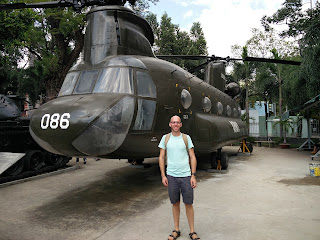I stayed in a hostel located some distance away from the so-called 'backpacker street' in District 1, the centre of town, because I wanted to see a more representative segment of the city. The hostel was great and in the course of visiting the sights over the two days I spent in the city itself, I found myself walking tens of kilometres and really getting a feel for the place.
Besides for visiting the main market and checking out the French architecture, I spent an afternoon at the war museum. After having been at the War Memorial in Seoul, it was interesting to encounter exhibits emanating from the opposite facet of the cold war dichotomy. Predictably, there was a lot of talk of 'the imperialist Americans and their puppets' and a distinct lack of emphasis on the indiscretions of the North Vietnamese and communist guerrillas. Nevertheless, for those able to look beyond the narrow focus, there are many enlightening artefacts and descriptions or photographs of incidents that are beyond dispute, as well as a harrowing explanation of the tragic effects of Agent Orange which, staggeringly, continue in some measure to this day.
From Saigon I visited a subterranean network of tunnels used by the Viet Cong, at Cochi, in the suburbs of the city, which was interesting but highly touristy, and I also took a two day tour of the Mekong Delta region, which had a similar touristy character. I did however enjoy the homestay in a house right alongside one of the river's many tributaries, and seeing the floating market which is actually a functioning market used by locals.
The day after returning to Saigon, I caught a bus to Dalat, an inland town in the mountains that was a French retreat during colonial times. The area, which is full of waterfalls and canyons, is known for offering numerous adventure activities. I partook in canyoning, a sport which includes abseiling, waterfall sliding and cliff jumping. It was one of the most enjoyable activities I've done on the trip so far, and it was nice to be forced (far) out of my comfort zone. Besides for the adventure sports and visiting the waterfalls and coffee plantations, an unusual attraction found in Dalat is the Crazy House, best described as a kind of walk-in Dr Seuss book, a large and still unfinished building that is a labyrinth of corridors and staircases.
I am currently on a long bus journey towards Hoi An, about which I've heard only good things and I'm excited to see what else the country has to offer, as I continue Northwards.
Happy Movember to those celebrating. I'll try to keep posting.
Love David
 |
| Chinook at the War Remnants Museum, Saigon |
 |
| Waterfall sliding in Dalat |
 |
| Abseiling into the 'washing machine', Dalat |
 |
| Elephant Falls, near Dalat |
 |
| The Crazy House |










